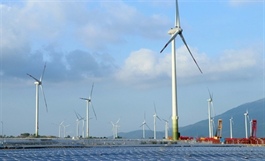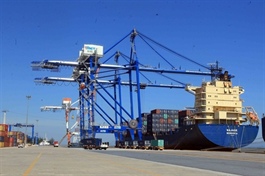Exploring new markets expected to fuel foreign trade
Exploring new markets expected to fuel foreign trade
Viet Nam witnessed declines in both exports and imports in the first four months of 2023, and exploring new markets is now considered one of the solutions to foreign trade bottlenecks.

Textile production at a garment company in HCM City. Exports of textile and footwear experienced the sharpest decreases in overseas shipments. — VNA/VNS Photo |
Difficulties facing the world economy continued affecting Viet Nam’s foreign trade in April, as trade value totaled US$53.57 billion, falling 7.7 per cent month on month and 18.8 per cent year-on-year.
It stood at $210.79 billion in the first four months, down 13.6 per cent from a year earlier (compared to an increase of 16.6 per cent recorded in the same period last year), according to the Ministry of Industry and Trade (MoIT).
The MoIT blamed that fact on different causes, including high inflation in many countries and nosediving purchasing power, especially in terms of non-essential goods.
Such sectors as textile–garment, leather–footwear, wood, and fisheries whose main markets are the US and the EU, experienced the sharpest decreases in overseas shipments.
Besides, input factors like materials, personnel, and transportation saw surging costs while export prices remained almost unchanged, undermining the competitiveness of products.
Meanwhile, imports were estimated at $26.03 billion in April and $102.22 billion in the first four months, respectively dropping 8.1 per cent month-on-month and 15.4 per cent year-on-year (compared to the growth of 16.1 per cent in the same period last year).
Materials serving domestic production accounted for up to $88 billion, or 86 per cent of the four-month import turnover. The import value of this group of commodities fell 18 per cent from a year earlier due to the shortage of orders, the MoIT pointed out.
To address those difficulties, it will connect domestic enterprises and business associations with Viet Nam’s trade offices abroad to address their concerns.
The ministry will also reform and step up trade promotion in new and potential markets such as India, Africa, the Middle East, Latin America, and Eastern Europe, as well as those less affected by high inflation and holding positive growth prospects like the ones of the Association of Southeast Asian Nations (ASEAN).
The markets with an expanding middle class, including the Emerging 7 (E7) countries (China, India, Turkey, Russia, Mexico, Indonesia, and Brazil) and Halal markets like the Middle East, Malaysia, and Brunei, will also be tapped into, the MoIT added.
Diversifying markets is also a path chosen by many enterprises.
The Cong Thuong (Industry & Trade) newspaper cited Than Duc Viet, General Director of the Garment 10 Corporation, as saying that aside from traditional markets, his firm will also move to successfully enter new and potential ones such as Africa, the Middle East, and China.
In addition, the company will boost restructuring, digital transformation, and the use of renewable energy and green materials. It will also offer more suitable products with competitive prices to the domestic market, he noted.






















